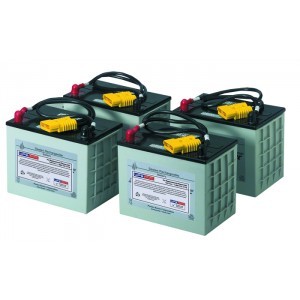In today’s data filled world, it has become increasingly crucial to maintain uptime for business continuity. To avoid costly downtime and sustain uptime in regards to electrical power, companies have to implement a comprehensive power distribution scheme along with emergency power support from an uninterruptible power system (UPS).
With the important role a UPS plays in keeping businesses up and running, operators also must consider the batteries that are powering the critical systems. How can facility managers make sure they are getting the most from their UPS batteries? To ensure optimal battery life, the maintenance of UPS batteries is a vital necessity since these crucial power sources are critical to a business’ power reliability, and the battery is one of the most vulnerable parts of a UPS.
The leading cause of load loss is battery failure, and knowing how to maintain and manage UPS batteries will prolong their life, saving time, and the potential for future headaches. When it comes to UPS deployments in larger systems, there are several important factors to consider in maximizing UPS battery life.
Battery Chemistry
UPS batteries are electrochemical devices. Their ability to store and deliver power slowly decreases over time. Even if you follow the guidelines for proper storage, usage and maintenance, batteries still require replacement after a certain period of time.
Positive grid corrosion has been the most common end-of-life factor for UPS batteries, which is a result of the normal aging process. This is due to the UPS battery chemistry and involves the gradual breakdown of the inner segments of the positive grid within the battery.
Cycling
During a power failure, a UPS operates on battery power. Once the power is restored, or a switch to power from a generator is complete, the batter is recharged for future use. This is called the discharge cycle.
When first installed, the battery is at 100 percent of rated capacity. Each discharge and subsequent recharge reduces its relative capacity by a small percentage. The length and quantity of discharge cycles determine the reduction in battery capacity.
Lead-acid, rechargeable batteries, can only undergo a certain number of discharge/recharge cycles before the chemistry is depleted. Once the chemistry is depleted, the cells fail and the battery will need to be replaced.
Maintenance
UPS reliability depends on battery service and maintenance. A gradual decrease in battery life can be monitored and evaluated through voltage checks, load testing or monitoring. Periodic preventive maintenance extends battery string life by preventing loose connections, removing corrosion and identifying bad batteries before they can affect the rest of the string.
At UPS Battery Center, our goal isn’t to only sell batteries, we want to inform and teach you about the amazing world of batteries, electricity and energy. Please check back for more interesting, helpful and informative articles about batteries and electricity.
Related Articles:
What is a Line-interactive UPS




